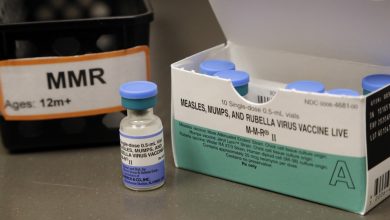
Blood test detects Alzheimer’s before symptoms appear
تحليل بسيط للدم يساعد على التنبوء بالإصابة بالزهايمر قبل ظهور أعراضه
A group of researchers is close to developing a blood test that can detect Alzheimer’s disease long before symptoms appear. The test will be extremely useful for scientists trying to understand and treat the condition.
One of the major issues that hamper Alzheimer’s research is that the disease is always caught at a relatively late stage.
This is because symptoms develop slowly over a number of years; they become obvious long after the condition has made changes in the brain.
As it stands, there are no simple ways to detect whether Alzheimer’s disease is developing in an individual.
The only reliable methods of diagnosis are positron emission tomography (PET) brain scans, which are time-consuming and expensive, and the analysis of cerebrospinal fluid (CSF) collected by a lumbar puncture, which is painful and invasive.
A study, published in the journal EMBO Molecular Medicine, describes a potential solution to this significant problem.
Detecting protein in the blood
One of the hallmarks of Alzheimer’s disease is an abnormal buildup of amyloid-beta plaques in the brain. Amyloid-beta is present in the healthy brain, but, in individuals with Alzheimer’s, the protein is folded incorrectly and accumulates. In its misfolded, sheet-like form, it is toxic to nerve cells.
Amyloid plaques can begin developing 15–20 years before symptoms of Alzheimer’s appear.
This unhealthy protein forms the basis of the groundbreaking blood test. The researchers, led by Klaus Gerwert, wanted to understand whether measuring the relative levels of healthy and pathological amyloid-beta in the blood could identify Alzheimer’s in its early — prodromal — stages.
Their new blood test works using immuno-infrared sensor technology; based on an antibody, the sensor extracts all amyloid-beta from the blood sample. The two versions of beta-amyloid absorb infrared light at different frequencies allowing the researchers to measure the relative levels of healthy and unhealthy protein.
Unlike other methods, the immuno-infrared sensor does not give a precise quantity of misfolded protein; rather, it provides information about the ratio between the healthy and unhealthy versions. This is beneficial as it is less impacted by the natural fluctuations of protein levels in the blood.
To investigate whether the test worked, the team of scientists, from Ruhr University Bochum in Germany, took data from the Swedish BioFINDER cohort, a study carried out by Oskar Hansson from Lund University in Sweden.
This initial phase of the study yielded encouraging results; in individuals who showed subtle, early symptoms of Alzheimer’s, the test detected changes in levels of amyloid-beta that correlated with abnormal deposits visualized using brain scans.
In other words, the test detected increased levels of misfolded amyloid-beta, which was later confirmed by a brain scan.
The next level
The obvious and vital next step was to see if abnormal amyloid-beta levels could be detected in individuals before Alzheimer’s symptoms developed.
For this, they took data from the ESTHER cohort study. They assessed blood samples from 65 individuals who later went on to develop Alzheimer’s disease. These blood samples were compared with 809 individuals who did not go on to develop the disease.
On average, the blood test could detect Alzheimer’s in individuals 8 years before clinical symptoms became apparent.
It correctly diagnosed Alzheimer’s in 70 percent of cases and wrongly predicted that 9 percent would develop the disease. Overall, the diagnostic accuracy was 86 percent.
Compared with a lumbar puncture or a PET scan, a simple blood test would be much more useful to clinicians and researchers alike. Although, at this stage, the test is not perfect, it would be a useful way to pick out those who may be at risk of developing Alzheimer’s before sending them for a more thorough investigation.
The findings are exciting and will provide a welcome tool in the hunt for Alzheimer’s treatments. Further down the line, the team plans to use a similar technology to detect a biomarker (alpha-synuclein) associated with another condition that is difficult to detect early: Parkinson’s disease.
source: medicalnewstoday.com
أظهرت دراسة أمريكية حديثة أجراها معهد الطب التابع لجامعة واشنطن في سانت لويس والمركز الألماني لأمراض الأعصاب في ألمانيا، أن فحصا بسيطا للدم يمكن أن يكشف بصورة موثوقة، علامات تضرر الدماغ في الأشخاص السائرين نحو مرض ألزهايمر، حتى قبل أن تظهر عليهم أعراض المرض ولاسيما عدم وضوح الأفكار وفقدان الذاكرة.
ودرس الباحثون أحوال أكثر من 400 شخص شاركوا بهذه الدراسة المخصصة لشبكة احتمالات ألزهايمر الوراثي، من بينهم 247 شخصا يحملون جينات موروثة، و162 شخصا ليس بين ذويهم من تأثر بالمرض، وقام كافة المشاركين بالدراسة بزيارة عيادة تابعة لشبكة الدراسة، وفحصوا عينة من الدم وأخذوا فحصا شعاعيا للدماغ وكامل الاختبارات المعرفية أو الإدراكية.
ووجد الباحثون أن أولئك الحاملين لصفات جينية وراثية تتعلق بألزهايمر، يكون مستوى البروتين عندهم أعلى عند المستوى المتعارف عليه، ويرتفع مع مرور الزمن، وفي المقابل، كان مستوى البروتين عند الذين لا يحملون جينات وراثية، منخفضا، ومستقرا عموما، وهذا الفارق يمكن ملاحظته قبل 16 عاما من ظهور أعراض المرض واحتمال تزايدها.
ووجد الباحثون عندما فحصوا الصور الشعاعية لدماغ المشاركين بالدراسة، أن مستويات البروتين ترتفع سريعا مقارنة مع سرعة تضاؤل واضمحلال جزء الدماغ الخاص بالذاكرة.
وقال ماتياس جوكر، كبير الباحثين في هذه الدراسة في ألمانيا “سيكون من المهم تأكيد نتائج بحثنا حول مرض ألزهايمر، وتحديد الفترة الزمنية التي يتطور فيها المرض، وتوقعاتنا حوله”.
ونشرت نتائج الدراسة في مجلة الطب الطبيعي “نيتشر ميديسن”.



